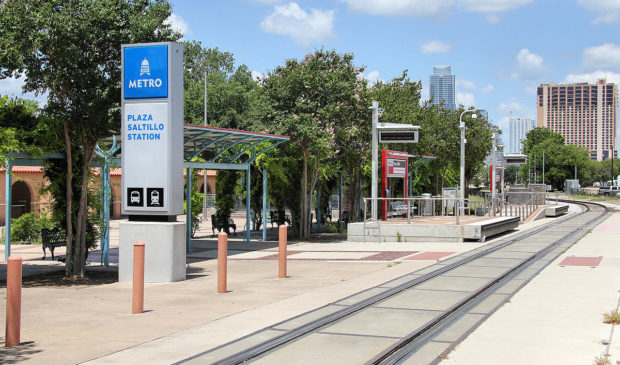Capital Metro adds new light rail line to Project Connect recommendation
Thursday, May 7, 2020 by
Ryan Thornton An update to regional population estimates has prompted the Capital Metropolitan Transportation Authority to make a major change to its proposal for Project Connect.
In a memo posted Wednesday, CEO Randy Clarke and Assistant City Manager Gina Fiandaca said the more recent demographics indicate that the Gold Line, previously envisioned as a bus rapid transit route connecting Republic Square with Austin Community College’s Highland Campus, will need the extra capacity provided by light rail.
In previous system updates, bus rapid transit has been effectively taken off the table as an option for both the Orange and Blue lines, the system’s primary high-capacity routes, due to limited ridership capacity.
The updated regional population data was adopted by the Capital Area Metropolitan Planning Organization this week as part of its 2045 Regional Transportation Plan. While the Travis County census may show that data to be inaccurate, the planning agency currently predicts the county’s population to swell to nearly 2.2 million by 2045.
Previously, the transit agency had included demographics from CAMPO’s 2040 plan in its analysis for the Gold Line. The 2040 modeling predicted 1.7 million residents in Travis County by 2040.
The transit agency is also cutting back on its recommendation for improvements to the Red Line, the city’s only existing commuter rail line. “As the final system analysis was completed, the limited gain on extending Red Line platforms did not yield enough additional ridership to justify the $380 million investment over the next 30-year period.”
The $380 million saved on the Red Line is roughly equivalent to the estimated $400 million in capital costs to build light rail infrastructure for the six miles and 10 stations of the Gold Line. According to the agency’s estimates from January, light rail for the Gold Line would also cost roughly $7 million in ongoing operations and maintenance in 2028 dollars.
In the middle of an economic crisis, funding the system remains an open question. The agency is still counting on a roughly 40 percent match from the federal government, leaving city taxpayers with a burden of around $5.6 billion for the entire system.
The city and Capital Metro are currently working together to create a plan to manage investments and system build-out through a local government corporation or other joint agency.
Capital Metro is resuming its Project Connect public engagement effort today with a self-guided, virtual open house and a series of community meetings streamed live via Zoom through the rest of the month. The new public engagement schedule will be available on the Project Connect website on Friday.
The agency plans to offer a more detailed update on the new system recommendation at its May 22 board meeting and again at the May 28 Mobility Committee meeting. The final system recommendation will be presented for adoption on June 10 at a joint meeting of City Council and the Capital Metro board.
“We will get through this together. When we do, there will be more need than ever for a high-quality transit system that can provide access to jobs, education and health care, ease traffic, address climate change, and help resolve longstanding community inequities,” the memo stated.
Photo made available through a Creative Commons license.
The Austin Monitor’s work is made possible by donations from the community. Though our reporting covers donors from time to time, we are careful to keep business and editorial efforts separate while maintaining transparency. A complete list of donors is available here, and our code of ethics is explained here.
You're a community leader
And we’re honored you look to us for serious, in-depth news. You know a strong community needs local and dedicated watchdog reporting. We’re here for you and that won’t change. Now will you take the powerful next step and support our nonprofit news organization?




